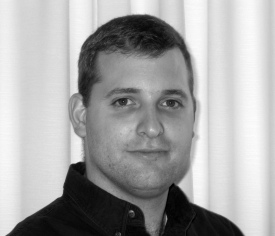| Conference Publications... |
|
Yu-Li Hsueh;
Matthew S. Rogge; Wei-Tao Shaw; Jaedon Kim; L. G. Kazovsky,
Spectral Shaping Line Codes for Instant Upgrade of Existing
Passive Optical Networks,
IEEE Optical Fiber Communications conference (OFC 2004), March, 2004. |
|
Matthew S. Rogge; Yu-Li Hsueh; L. G.
Kazovsky, A Novel Passive Optical Network with Dynamic
Wavelength Allocation,
IEEE Optical Fiber Communications conference (OFC 2004), March, 2004. |
|
Matthew S. Rogge; Kapil V. Shrikhande;
Carlo Tosetti; Hopil Bae; L. G. Kazovsky, Circuits over HORNET (CoHo) -
Guaranteed Bit Rates over a Packet-based Metro Network, IEEE
Globecom 2003,
San Francisco, CA, December, 2003. |
|
S.
S.-H. Yam; Matthew S. Rogge; Joseph Kim;
Eric Montgomery; L. G. Kazovsky, 40Gbps/Wavelength
Transmission over
Multimode Fiber for Optical Backplane Applications, IASTED
International Conference on Communications, Internet and Information
Technologies (CIIT' 2003), Scottsdale, Arizona, November, 2003 |
|
Matthew S. Rogge; Kapil V. Shrikhande;
Hopil Bae; Carlo Tosetti; L. G. Kazovsky, Circuits over HORNET (CoHo)
Demonstration: guaranteed bit rates over a packet-based network,
European Conference on Optical Communications (ECOC 2003), Rimini,
Italy, Th1.4.2, September, 2003. |
|
Fu-Tai
An; Kyeong Soo Kim; Yu.-Li.
Hsueh; Matthew S. Rogge; Wei-Tao Shaw; L. G. Kazovsky, "Evolution, Challenges
and Enabling Technologies for Future WDM-Based Optical Access
Networks," 2nd Symposium on Photonics, Networking and Computing,
Cary,
North Carolina, pp. 1449-1453, September, 2003. |
| |
Fu-Tai An;
Hopil Bae; Yu-Li Hsueh;
Kyeong Soo Kim; Matthew S. Rogge; Leonid G. Kazovsky,
A New Media Access Control Protocol Guaranteeing Fairness
Among Users in Ethernet-based Passive Optical Networks,
IEEE Optical Fiber Communications Conference (OFC 2003), Atlanta,
Georgia,
March, 2003. |
| |
Eric S. Hu; Ian M. White; Kapil
Shrikhande; Matthew
S. Rogge; K. K. Y. Wong; F.-T. An; S. H. Yam; Y.-L. Hsueh; L. K.
Kazovsky,
Photonics Research in Optical Communications Research
Laboratory (OCRL) at Stanford University,
Stanford Photonics Research Center (SPRC) 2002 Annual Meeting,
Stanford, CA, 63-65, September, 2002. |
 |
Ian M. White; Matthew S. Rogge; Yu-Li
Hsueh; Kapil Shrikhande; Leonid G. Kazovsky,
Experimental demonstration of the HORNET survivable
bi-directional ring architecture,
Optical Fiber Communications Conference (OFC 2002), Anaheim, CA, WW1,
March, 2002. |
| |
Leonid. G. Kazovsky; Ian. M. White;
Kapil Shrikhande; Matthew S. Rogge,
High Capacity Metropolitan Area Networks for the Next
Generation Internet,
Asilomar Conference on Signals and Systems, Monterey, CA, MA1b-1,
November, 2001. |
 |
Kapil Shrikhande; Ian M. White; Matthew
S. Rogge; F-T. An; E. S. Hu; S. S-H. Yam; Leonid G. Kazovsky,
Performance Demonstration of a Fast-Tunable Transmitter and
Burst-Mode Packet Receiver for HORNET,
Optical Fiber Communications conference, Anaheim, CA, ThG2-1, March,
2001. |
| |
Leonid G. Kazovsky; Kapil Shrikhande;
Ian M. White; Matthew S. Rogge; D. Wonglumsom,
Optical Metropolitan Area Networks,
Optical Fiber Communication conference, Anaheim, CA, WU1-1, March, 2001. |
 |
Ian M. White; Kapil Shrikhande; Matthew
S.
Rogge; S. M. Gemelos; D. Wonglumsom; G. Desa; Y. Fukashiro; Leonid G.
Kazovsky,
Architecture and Protocols for HORNET: A Novel
Packet-over-WDM
Multiple-Access MAN,
Globecom '00, San Francisco, CA, 1298-1302, November, 2000. |
 |
Kapil Shrikhande; Anand Srivatsa; Ian M.
White; D. Wonglumsom; Matthew S. Rogge; S. M. Gemelos; Leonid G.
Kazovsky,
CSMA/CA MAC Protocols for IP-HORNET: An IP over WDM
Metropolitan Area Ring Network,
IEEE Globecom 2000, San Francisco, 1303-1307, November, 2000. |
 |
Ian M. White; Yasuyuki Fukashiro; Kapil
Shrikhande; D. Wonglumsom; Matthew S. Rogge; Moritz Avenarius; L. G.
Kazovsky,
Experimental Demonstration of a Media Access Protocol for
HORNET: A WDM Multiple Access Metropolitan Area Ring Network,
IEEE Optical Fiber Communications conference (OIFC 2000), Baltimore,
MD, WD3, 50-52,
March, 2000. |
 |
Yasuyuki Fukashiro; Kapil Shrikhande; M.
Avenarius; Matthew S. Rogge; I. M. White; D. Wonglumsom; L. G. Kazovsky,
Fast and fine wavelength tuning of a GCSR laser using a
digitally controlled driver,
IEEE Optical Fiber Communications conference (OFC 2000), Baltimore,
Maryland, WM43,
338-340, March, 2000. |

